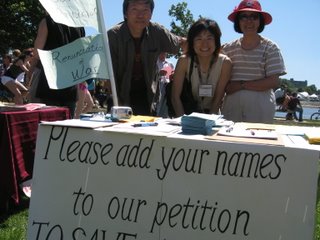 On June 26th afternoon, the workshop 'Article 9 of the Japanese Constitution: Common Treasure of the Humankind for Peace' was held at UBC or the University of British Columbia (photo by Peace Boat), sponsored by Peace Boat, Hague Appeal for Peace, VSA9, Gensuikyo , Gensuikin and Hidankyo. I shared the panel with the 6 other speakers who gave different perspectives on how the Peace Clause of the Japanese Constitution should be upheld and utilized throughout the world for the survival of the human kind and this earth. There were more than 200 people in the audience, and I was honoured to present VSA9, its people and activities at such a significant international conference. The detailed report of the event by the moderator Akira Kawasaki of Peace Boat can be found on the website of the Global Article 9 Campaign.
On June 26th afternoon, the workshop 'Article 9 of the Japanese Constitution: Common Treasure of the Humankind for Peace' was held at UBC or the University of British Columbia (photo by Peace Boat), sponsored by Peace Boat, Hague Appeal for Peace, VSA9, Gensuikyo , Gensuikin and Hidankyo. I shared the panel with the 6 other speakers who gave different perspectives on how the Peace Clause of the Japanese Constitution should be upheld and utilized throughout the world for the survival of the human kind and this earth. There were more than 200 people in the audience, and I was honoured to present VSA9, its people and activities at such a significant international conference. The detailed report of the event by the moderator Akira Kawasaki of Peace Boat can be found on the website of the Global Article 9 Campaign.
On June 27th evening, VSA9 hosted a party with World Peace Forum delegates from Japan at Floata Seafood Restaurant in the Chinatown in Vancouver Downtown. Our reserved space was packed with 180+ people including guests from the local peace communities and other international delegates of the Forum. One of the highlights of this event was the presentation of Kinuko Laskey's bust by Keith Shields (photo by JALISA) to the Japanese delegates, with the prospect that Kinuko's bust will find a permanent home in Hiroshima. Kinuko was a Hiroshima A-Bomb survivor who married Canadian David Laskey, and dedicated the last 20+ years of her life educating people throughout North America about the horrors of nuclear bombs. She passed away in 2004, and David Laskey (far right in the photo), who always supported Kinuko's peace activities, has succeeded her cause.
 On the last day of the Peace Forum, Peace Boat came to Vancouver with its one thousand passengers and hosted a series of events for the Forum. I participated in the noontime program 'Travelling the World, Changing the World - People to People Diplomacy onboard Peace Boat' with speakers including Peace Boat's founder Tatsuya Yoshioka and Hague Appeal for Peace's Cora Weiss. What stood out for me in those speeches were Yoshioka's comment about ships as effective vehicle for connecting people and Weiss's stress on education and the role of women for creating world peace.
On the last day of the Peace Forum, Peace Boat came to Vancouver with its one thousand passengers and hosted a series of events for the Forum. I participated in the noontime program 'Travelling the World, Changing the World - People to People Diplomacy onboard Peace Boat' with speakers including Peace Boat's founder Tatsuya Yoshioka and Hague Appeal for Peace's Cora Weiss. What stood out for me in those speeches were Yoshioka's comment about ships as effective vehicle for connecting people and Weiss's stress on education and the role of women for creating world peace. The World Peace Forum concluded with Vancouver Appeal for Peace, which included a recommendation for constitutional renunciation of war with Japan's Article 9 as an example. In the photo is the performance by the young passengers of Peace Boat at the Forum's Closing Ceremony in front of Vancouver Art Gallery, which was followed by an evening peace walk from the Gallery to Canada Place where the very last event of the Forum was held - 'Bon Voyage' to Peace Boat.
The World Peace Forum concluded with Vancouver Appeal for Peace, which included a recommendation for constitutional renunciation of war with Japan's Article 9 as an example. In the photo is the performance by the young passengers of Peace Boat at the Forum's Closing Ceremony in front of Vancouver Art Gallery, which was followed by an evening peace walk from the Gallery to Canada Place where the very last event of the Forum was held - 'Bon Voyage' to Peace Boat.
Here is a picture from the VSA9 picnic that celebrated the World Peace Forum success, at the Spanish Banks Beach in Vancouver. This is a perfect picture of peace - people of all ages being safe and happy, smiling, enjoying food and beautiful environment.
We must create a world where this is a reality for all people.
My heartfelt thanks to all that shared the incredible experiences of the Peace Forum.
With lots of love and the best wishes for the new year,
Satoko





 The Asia Regional Conference
The Asia Regional Conference